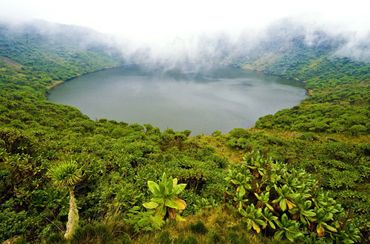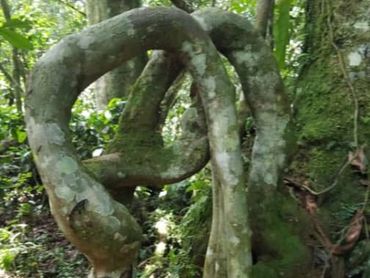
Explore Bwindi Impenetrable National Park
The Bwindi Impenetrable National Park is a national park in southwestern Uganda. It is part of the Bwindi Impenetrable Forest and is situated along the Democratic Republic of Cong border next to the Virunga National Park. Composed of 321 km2 (124 sq mi) of both montane and lowland forest, it is accessible only on foot.
Species diversity is a feature of the park. It provides habitat for 120 species of mammals, 350 species of birds, 310 species of butterflies, 27 species of frogs, chameleons, geckos, and many endangered species. Floristically, the park is among the most diverse forests in East Africa, with more than 1,000 flowering plant species, including 200 species of trees and 104 species of ferns.
The park is a sanctuary for colobus monkeys, chimpanzees, and many birds such as hornbills and truccoes. It is most notable for the 400 Bwindi gorillas, half of the world's population of the mountain gorillas. Fourteen mountain gorilla groups live in four different sectors of Buhoma, Ruhijja, Rushaga and the Nkuringo in the districts of Kanungu, Kabale and Kisoro respectively, all under the management of Uganda Wildlife Authority.
Experience the great Activities of Bwindi Impenetrable NP
Explore the forest by bike
Explore the forest by bike
Explore the forest by bike

In the Buhoma area of Bwindi Impenetrable Forest, visitors have the chance to explore the park by mountain bike. There is a 13km trail leading cyclists around the forest to the shores of the Ivi River. The trail takes around 6-7 hours, including time to stop and soak in the incredible scenery and admire the wildlife.
This mountain biking experience is organised by Buhoma Community Rest Camp and is part of a community initiative called ‘Ride 4 a Woman’ which supports local women struggling with HIV, domestic violence, and poverty. By renting a bike, visitors directly support the great efforts of the organisation in helping women and the local community.
Due to the success of the organisation, they have expanded to now offer a sewing and weaving cooperative for women. Visitors are welcome to spend time with the women and try their hand at weaving
Bird Watching
Explore the forest by bike
Explore the forest by bike

Bird lovers are also in for a treat. The forest has 348 different species of forest birds recorded in the park, 23 unique to the region. Some highlights are the African green broadbill, Chapin’s flycatcher, and Shelley’s crimson-wing. The main nesting season is in May and June, with abundant food for the birds from May to September. Migratory birds can be found in Bwindi from November to April.
Many of the bird watching tours on offer take place in the Buhoma area, along village paths and in the forest margins. They also take place in the Ruhija area of the park where knowledgeable guides lead visitors through the park to discover a variety of forest and swamp birds in their natural habitat. Wherever visitors choose to go in Bwindi, the birds are always plentiful and easy to spot.
Spot the Butterflies!
Explore the forest by bike
Spot the Butterflies!

For fans of butterflies, Bwindi is a dream. The forest is the most important place in all of Africa for montane forest butterflies, hosting 202 different species representing 84% of Uganda’s total, including eight only found in the national park.
Take a walk through the forest to catch a glimpse of the incredibly rare African giant swallowtail, or Cream-banded swallowtail
Nature Walks
Visiting the Batwa People
Spot the Butterflies!

Nature walks in Bwindi take you through the verdant forest, and there are a number of routes to choose from depending on your interests, fitness, and time constraints.
If you're keen to get in some good trekking during your trip, Bwindi has some of the best trails in the south-west.
There are 6 trails to choose from, each taking you through a different part of the forest. En route, you'll discover some of Bwindi's lesser-visited landmarks including the Muyanga waterfall, Habinyanja swamp, and the ‘African Corner’ named after a piece of rock that is said to depict a map of Africa.
Gorilla Tracking
Visiting the Batwa People
Visiting the Batwa People

Gorilla tracking usually begins with briefing early in the morning. The briefing covers important topics such as how to act around the primates, what to expect and what to pack. The actual tracking can take between 30 minutes to 4 hours depending on the gorilla family and their location. An advance team of trackers is sent earlier to locate the primates.
The gorilla habituation experience was introduced in Bwindi more recently. This experience is currently only possible in Bwindi forest – not in Rwanda and not in Congo. This activity allows primate lovers more time (four hours) observing the primates instead of the standard gorilla trekking (four hours).
Visiting the Batwa People
Visiting the Batwa People
Visiting the Batwa People

The Batwa pygmies are believed to be the oldest indigenous tribe in Uganda. Whereas most of the other tribes in Uganda migrated from various parts of Africa to their current locations, the Batwa had lived in Bwindi forest for over 5,000 years.
Unfortunately the Batwa were evicted from Bwindi and Mgahinga Gorilla National park. The reason for their eviction among others was to protect the Mountain gorillas from diseases by limiting contact with humans. Like we have already discussed before, the Batwa now live outside the park. Visiting the Batwa provides a unique opportunity to be with a true indigenous African tribe and learn about their ancient culture and way of life.
Explore Photos for Bwindi Impenetrable National Park








Copyright © 2025 Seru Adventure Safaris - All Rights
Email: serusafaris@gmail.com